Leadership and Healthcare: Implementation and Managing Change in Healthcare Organizations
VerifiedAdded on 2023/03/17
|15
|4406
|51
AI Summary
This assignment discusses the implementation and management of change in healthcare organizations, specifically focusing on the case study of implementing electronic healthcare technologies in a mental healthcare ward. It explores the barriers and challenges faced by employees and provides recommendations for effective change management. The importance of compassionate leadership in healthcare is also highlighted.
Contribute Materials
Your contribution can guide someone’s learning journey. Share your
documents today.

Running head: LEADERSHIP AND HEALTHCARE
LEADERSHIP AND HEALTHCARE
Name of the student:
Name of the university:
Author note:
LEADERSHIP AND HEALTHCARE
Name of the student:
Name of the university:
Author note:
Secure Best Marks with AI Grader
Need help grading? Try our AI Grader for instant feedback on your assignments.
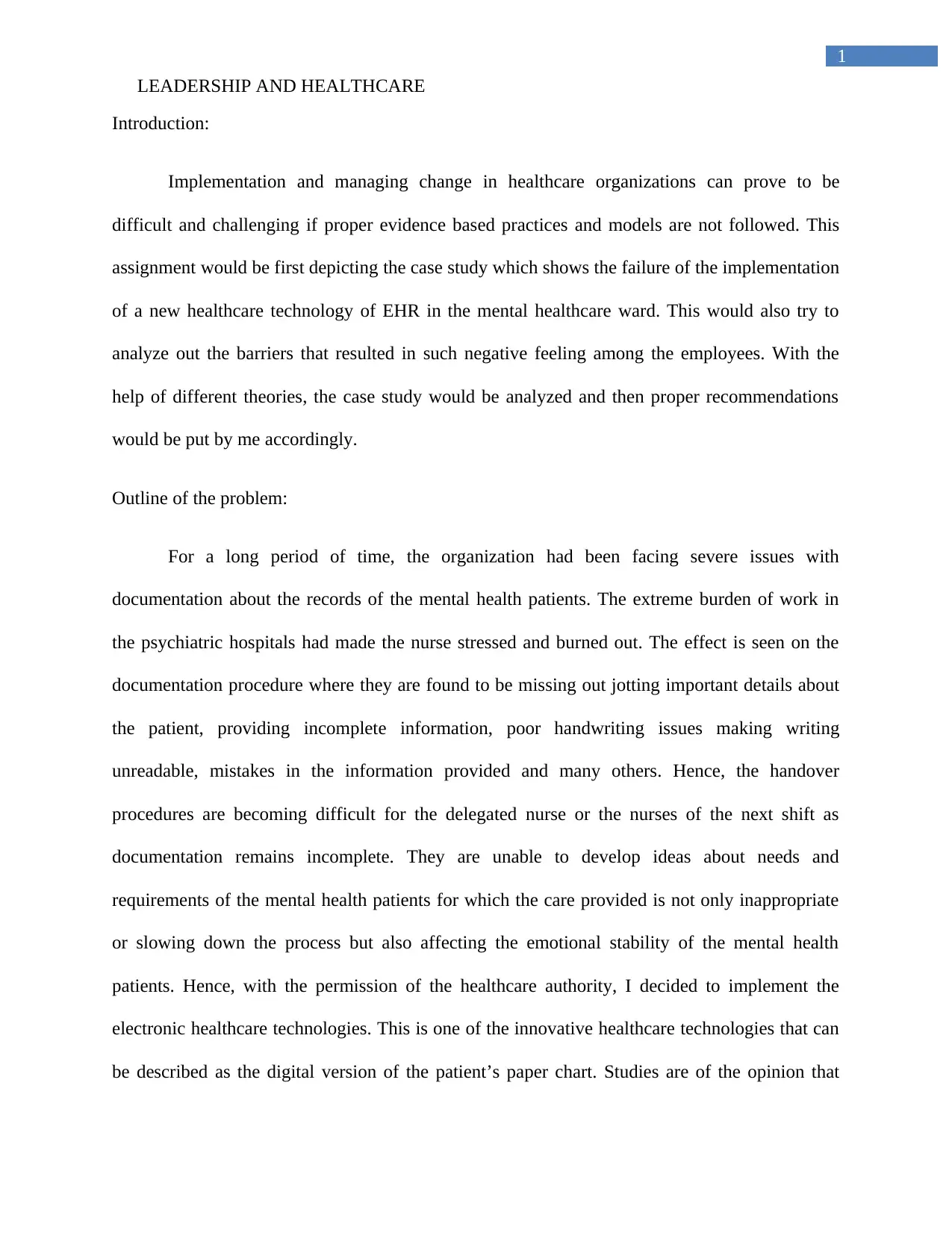
1
LEADERSHIP AND HEALTHCARE
Introduction:
Implementation and managing change in healthcare organizations can prove to be
difficult and challenging if proper evidence based practices and models are not followed. This
assignment would be first depicting the case study which shows the failure of the implementation
of a new healthcare technology of EHR in the mental healthcare ward. This would also try to
analyze out the barriers that resulted in such negative feeling among the employees. With the
help of different theories, the case study would be analyzed and then proper recommendations
would be put by me accordingly.
Outline of the problem:
For a long period of time, the organization had been facing severe issues with
documentation about the records of the mental health patients. The extreme burden of work in
the psychiatric hospitals had made the nurse stressed and burned out. The effect is seen on the
documentation procedure where they are found to be missing out jotting important details about
the patient, providing incomplete information, poor handwriting issues making writing
unreadable, mistakes in the information provided and many others. Hence, the handover
procedures are becoming difficult for the delegated nurse or the nurses of the next shift as
documentation remains incomplete. They are unable to develop ideas about needs and
requirements of the mental health patients for which the care provided is not only inappropriate
or slowing down the process but also affecting the emotional stability of the mental health
patients. Hence, with the permission of the healthcare authority, I decided to implement the
electronic healthcare technologies. This is one of the innovative healthcare technologies that can
be described as the digital version of the patient’s paper chart. Studies are of the opinion that
LEADERSHIP AND HEALTHCARE
Introduction:
Implementation and managing change in healthcare organizations can prove to be
difficult and challenging if proper evidence based practices and models are not followed. This
assignment would be first depicting the case study which shows the failure of the implementation
of a new healthcare technology of EHR in the mental healthcare ward. This would also try to
analyze out the barriers that resulted in such negative feeling among the employees. With the
help of different theories, the case study would be analyzed and then proper recommendations
would be put by me accordingly.
Outline of the problem:
For a long period of time, the organization had been facing severe issues with
documentation about the records of the mental health patients. The extreme burden of work in
the psychiatric hospitals had made the nurse stressed and burned out. The effect is seen on the
documentation procedure where they are found to be missing out jotting important details about
the patient, providing incomplete information, poor handwriting issues making writing
unreadable, mistakes in the information provided and many others. Hence, the handover
procedures are becoming difficult for the delegated nurse or the nurses of the next shift as
documentation remains incomplete. They are unable to develop ideas about needs and
requirements of the mental health patients for which the care provided is not only inappropriate
or slowing down the process but also affecting the emotional stability of the mental health
patients. Hence, with the permission of the healthcare authority, I decided to implement the
electronic healthcare technologies. This is one of the innovative healthcare technologies that can
be described as the digital version of the patient’s paper chart. Studies are of the opinion that
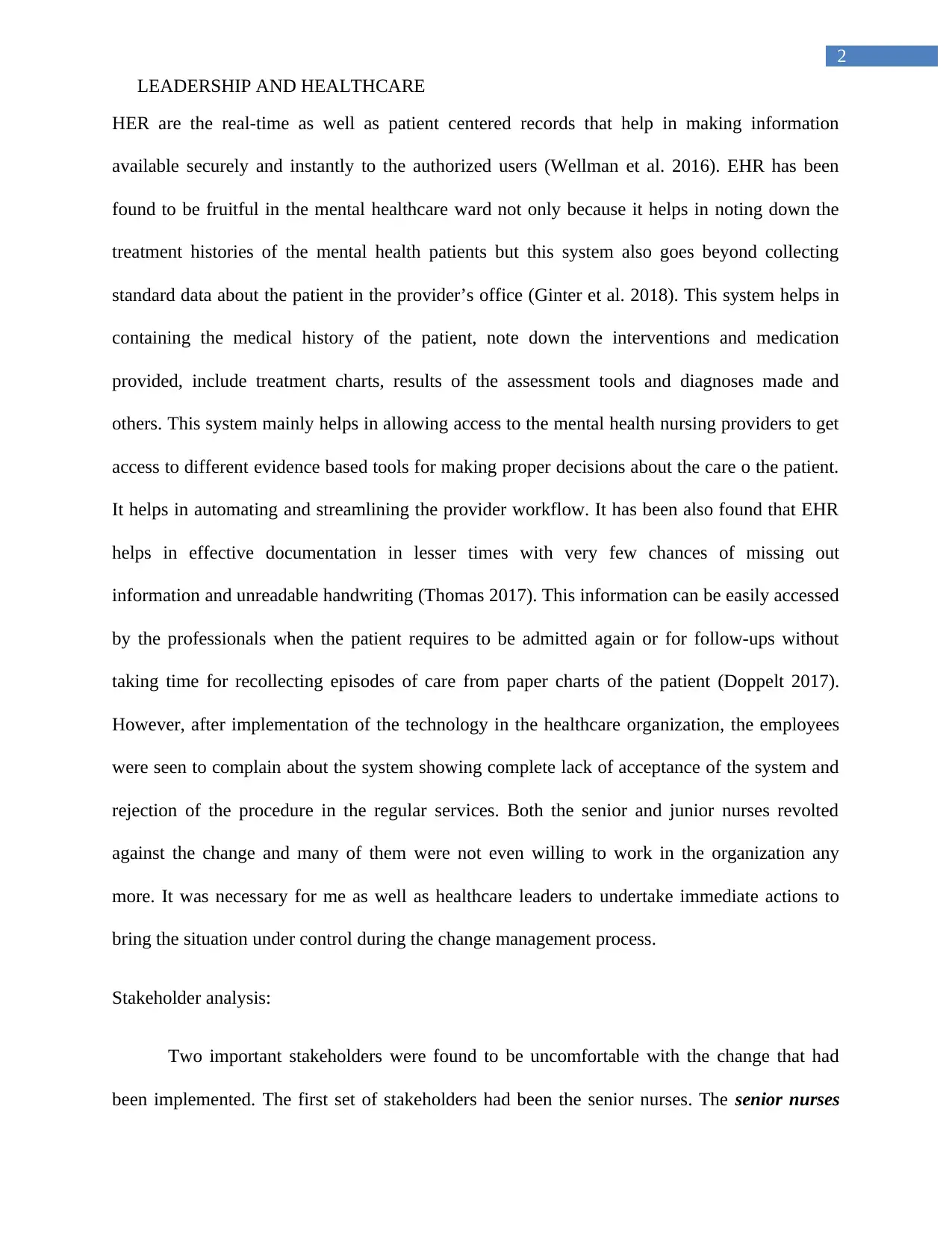
2
LEADERSHIP AND HEALTHCARE
HER are the real-time as well as patient centered records that help in making information
available securely and instantly to the authorized users (Wellman et al. 2016). EHR has been
found to be fruitful in the mental healthcare ward not only because it helps in noting down the
treatment histories of the mental health patients but this system also goes beyond collecting
standard data about the patient in the provider’s office (Ginter et al. 2018). This system helps in
containing the medical history of the patient, note down the interventions and medication
provided, include treatment charts, results of the assessment tools and diagnoses made and
others. This system mainly helps in allowing access to the mental health nursing providers to get
access to different evidence based tools for making proper decisions about the care o the patient.
It helps in automating and streamlining the provider workflow. It has been also found that EHR
helps in effective documentation in lesser times with very few chances of missing out
information and unreadable handwriting (Thomas 2017). This information can be easily accessed
by the professionals when the patient requires to be admitted again or for follow-ups without
taking time for recollecting episodes of care from paper charts of the patient (Doppelt 2017).
However, after implementation of the technology in the healthcare organization, the employees
were seen to complain about the system showing complete lack of acceptance of the system and
rejection of the procedure in the regular services. Both the senior and junior nurses revolted
against the change and many of them were not even willing to work in the organization any
more. It was necessary for me as well as healthcare leaders to undertake immediate actions to
bring the situation under control during the change management process.
Stakeholder analysis:
Two important stakeholders were found to be uncomfortable with the change that had
been implemented. The first set of stakeholders had been the senior nurses. The senior nurses
LEADERSHIP AND HEALTHCARE
HER are the real-time as well as patient centered records that help in making information
available securely and instantly to the authorized users (Wellman et al. 2016). EHR has been
found to be fruitful in the mental healthcare ward not only because it helps in noting down the
treatment histories of the mental health patients but this system also goes beyond collecting
standard data about the patient in the provider’s office (Ginter et al. 2018). This system helps in
containing the medical history of the patient, note down the interventions and medication
provided, include treatment charts, results of the assessment tools and diagnoses made and
others. This system mainly helps in allowing access to the mental health nursing providers to get
access to different evidence based tools for making proper decisions about the care o the patient.
It helps in automating and streamlining the provider workflow. It has been also found that EHR
helps in effective documentation in lesser times with very few chances of missing out
information and unreadable handwriting (Thomas 2017). This information can be easily accessed
by the professionals when the patient requires to be admitted again or for follow-ups without
taking time for recollecting episodes of care from paper charts of the patient (Doppelt 2017).
However, after implementation of the technology in the healthcare organization, the employees
were seen to complain about the system showing complete lack of acceptance of the system and
rejection of the procedure in the regular services. Both the senior and junior nurses revolted
against the change and many of them were not even willing to work in the organization any
more. It was necessary for me as well as healthcare leaders to undertake immediate actions to
bring the situation under control during the change management process.
Stakeholder analysis:
Two important stakeholders were found to be uncomfortable with the change that had
been implemented. The first set of stakeholders had been the senior nurses. The senior nurses
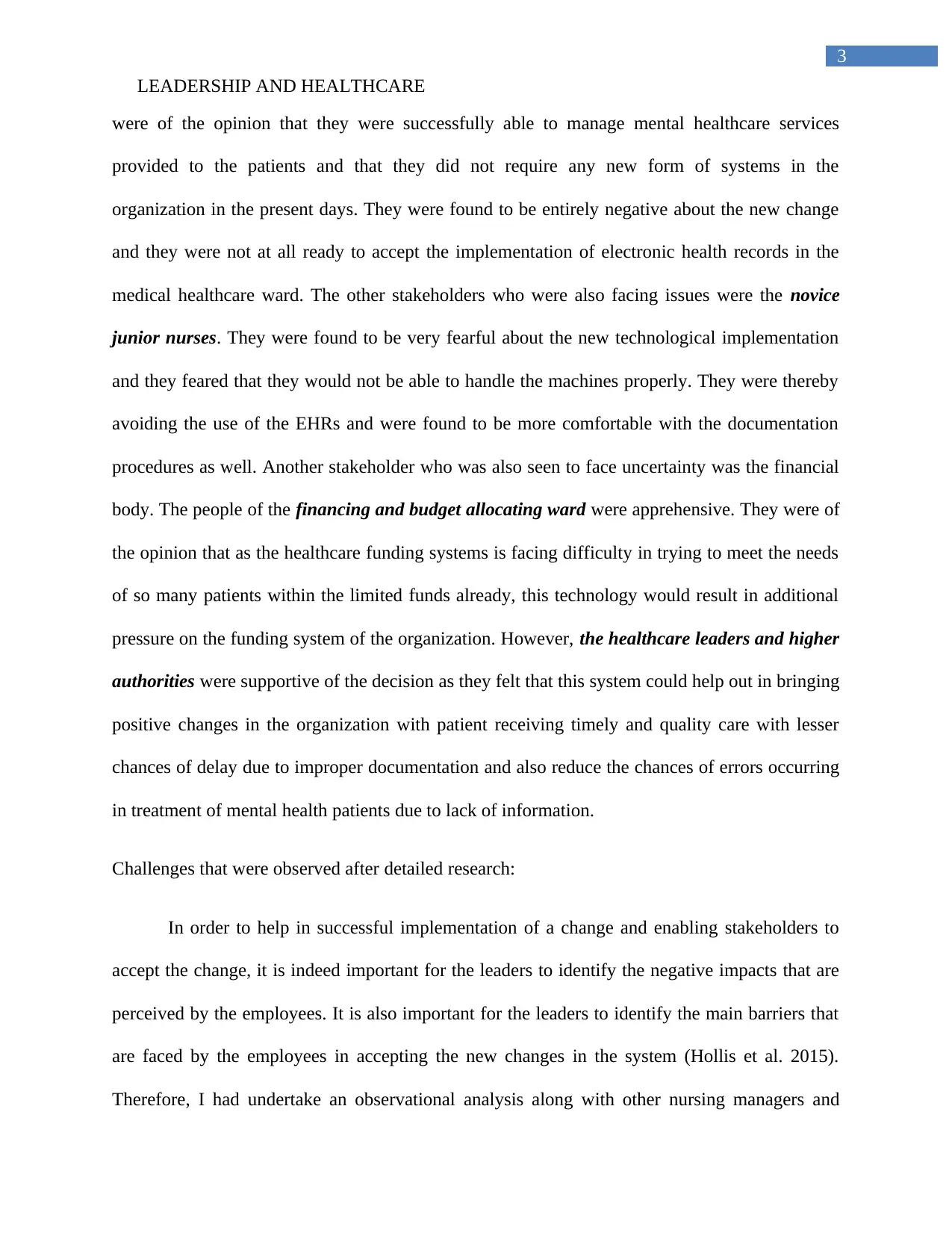
3
LEADERSHIP AND HEALTHCARE
were of the opinion that they were successfully able to manage mental healthcare services
provided to the patients and that they did not require any new form of systems in the
organization in the present days. They were found to be entirely negative about the new change
and they were not at all ready to accept the implementation of electronic health records in the
medical healthcare ward. The other stakeholders who were also facing issues were the novice
junior nurses. They were found to be very fearful about the new technological implementation
and they feared that they would not be able to handle the machines properly. They were thereby
avoiding the use of the EHRs and were found to be more comfortable with the documentation
procedures as well. Another stakeholder who was also seen to face uncertainty was the financial
body. The people of the financing and budget allocating ward were apprehensive. They were of
the opinion that as the healthcare funding systems is facing difficulty in trying to meet the needs
of so many patients within the limited funds already, this technology would result in additional
pressure on the funding system of the organization. However, the healthcare leaders and higher
authorities were supportive of the decision as they felt that this system could help out in bringing
positive changes in the organization with patient receiving timely and quality care with lesser
chances of delay due to improper documentation and also reduce the chances of errors occurring
in treatment of mental health patients due to lack of information.
Challenges that were observed after detailed research:
In order to help in successful implementation of a change and enabling stakeholders to
accept the change, it is indeed important for the leaders to identify the negative impacts that are
perceived by the employees. It is also important for the leaders to identify the main barriers that
are faced by the employees in accepting the new changes in the system (Hollis et al. 2015).
Therefore, I had undertake an observational analysis along with other nursing managers and
LEADERSHIP AND HEALTHCARE
were of the opinion that they were successfully able to manage mental healthcare services
provided to the patients and that they did not require any new form of systems in the
organization in the present days. They were found to be entirely negative about the new change
and they were not at all ready to accept the implementation of electronic health records in the
medical healthcare ward. The other stakeholders who were also facing issues were the novice
junior nurses. They were found to be very fearful about the new technological implementation
and they feared that they would not be able to handle the machines properly. They were thereby
avoiding the use of the EHRs and were found to be more comfortable with the documentation
procedures as well. Another stakeholder who was also seen to face uncertainty was the financial
body. The people of the financing and budget allocating ward were apprehensive. They were of
the opinion that as the healthcare funding systems is facing difficulty in trying to meet the needs
of so many patients within the limited funds already, this technology would result in additional
pressure on the funding system of the organization. However, the healthcare leaders and higher
authorities were supportive of the decision as they felt that this system could help out in bringing
positive changes in the organization with patient receiving timely and quality care with lesser
chances of delay due to improper documentation and also reduce the chances of errors occurring
in treatment of mental health patients due to lack of information.
Challenges that were observed after detailed research:
In order to help in successful implementation of a change and enabling stakeholders to
accept the change, it is indeed important for the leaders to identify the negative impacts that are
perceived by the employees. It is also important for the leaders to identify the main barriers that
are faced by the employees in accepting the new changes in the system (Hollis et al. 2015).
Therefore, I had undertake an observational analysis along with other nursing managers and
Secure Best Marks with AI Grader
Need help grading? Try our AI Grader for instant feedback on your assignments.
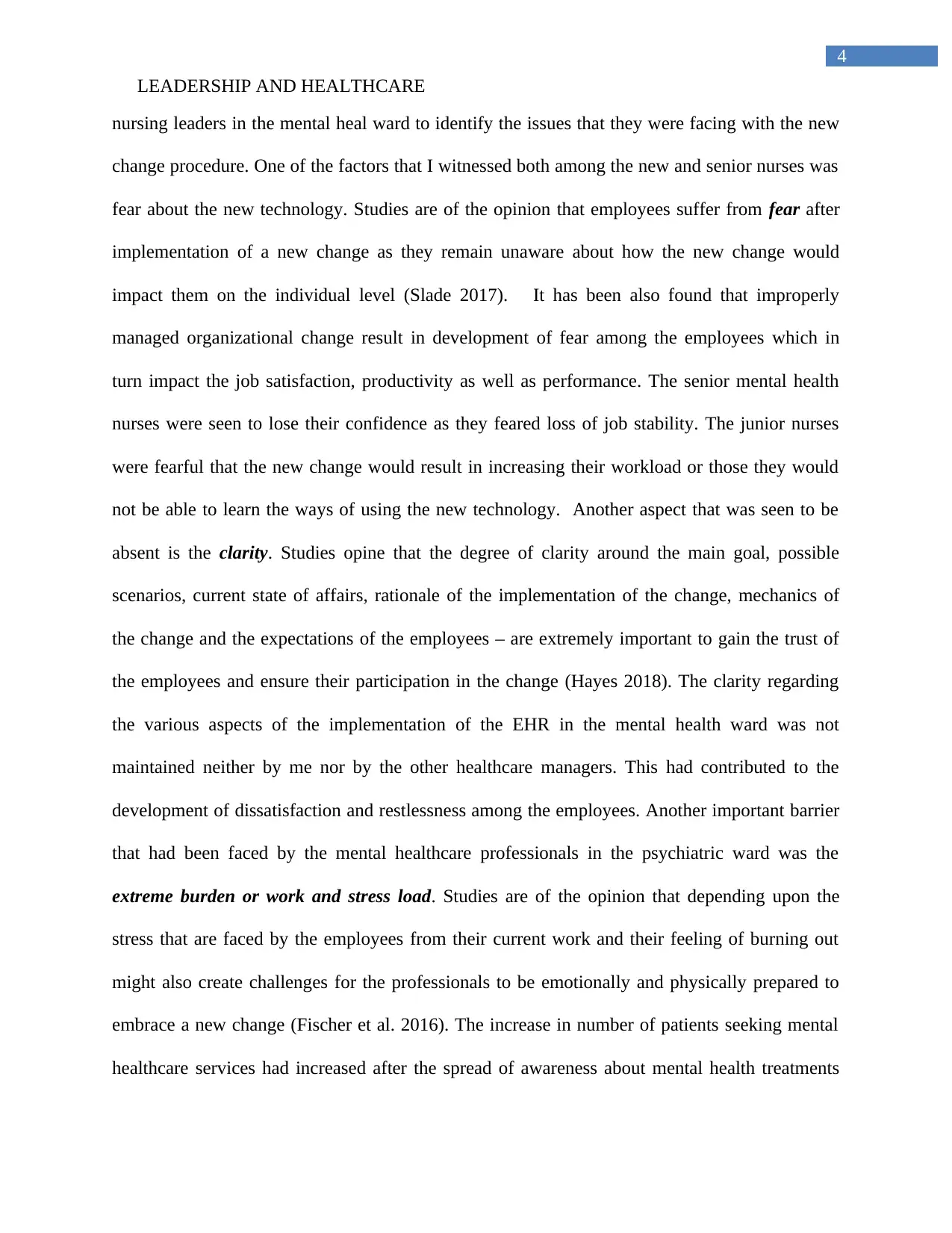
4
LEADERSHIP AND HEALTHCARE
nursing leaders in the mental heal ward to identify the issues that they were facing with the new
change procedure. One of the factors that I witnessed both among the new and senior nurses was
fear about the new technology. Studies are of the opinion that employees suffer from fear after
implementation of a new change as they remain unaware about how the new change would
impact them on the individual level (Slade 2017). It has been also found that improperly
managed organizational change result in development of fear among the employees which in
turn impact the job satisfaction, productivity as well as performance. The senior mental health
nurses were seen to lose their confidence as they feared loss of job stability. The junior nurses
were fearful that the new change would result in increasing their workload or those they would
not be able to learn the ways of using the new technology. Another aspect that was seen to be
absent is the clarity. Studies opine that the degree of clarity around the main goal, possible
scenarios, current state of affairs, rationale of the implementation of the change, mechanics of
the change and the expectations of the employees – are extremely important to gain the trust of
the employees and ensure their participation in the change (Hayes 2018). The clarity regarding
the various aspects of the implementation of the EHR in the mental health ward was not
maintained neither by me nor by the other healthcare managers. This had contributed to the
development of dissatisfaction and restlessness among the employees. Another important barrier
that had been faced by the mental healthcare professionals in the psychiatric ward was the
extreme burden or work and stress load. Studies are of the opinion that depending upon the
stress that are faced by the employees from their current work and their feeling of burning out
might also create challenges for the professionals to be emotionally and physically prepared to
embrace a new change (Fischer et al. 2016). The increase in number of patients seeking mental
healthcare services had increased after the spread of awareness about mental health treatments
LEADERSHIP AND HEALTHCARE
nursing leaders in the mental heal ward to identify the issues that they were facing with the new
change procedure. One of the factors that I witnessed both among the new and senior nurses was
fear about the new technology. Studies are of the opinion that employees suffer from fear after
implementation of a new change as they remain unaware about how the new change would
impact them on the individual level (Slade 2017). It has been also found that improperly
managed organizational change result in development of fear among the employees which in
turn impact the job satisfaction, productivity as well as performance. The senior mental health
nurses were seen to lose their confidence as they feared loss of job stability. The junior nurses
were fearful that the new change would result in increasing their workload or those they would
not be able to learn the ways of using the new technology. Another aspect that was seen to be
absent is the clarity. Studies opine that the degree of clarity around the main goal, possible
scenarios, current state of affairs, rationale of the implementation of the change, mechanics of
the change and the expectations of the employees – are extremely important to gain the trust of
the employees and ensure their participation in the change (Hayes 2018). The clarity regarding
the various aspects of the implementation of the EHR in the mental health ward was not
maintained neither by me nor by the other healthcare managers. This had contributed to the
development of dissatisfaction and restlessness among the employees. Another important barrier
that had been faced by the mental healthcare professionals in the psychiatric ward was the
extreme burden or work and stress load. Studies are of the opinion that depending upon the
stress that are faced by the employees from their current work and their feeling of burning out
might also create challenges for the professionals to be emotionally and physically prepared to
embrace a new change (Fischer et al. 2016). The increase in number of patients seeking mental
healthcare services had increased after the spread of awareness about mental health treatments
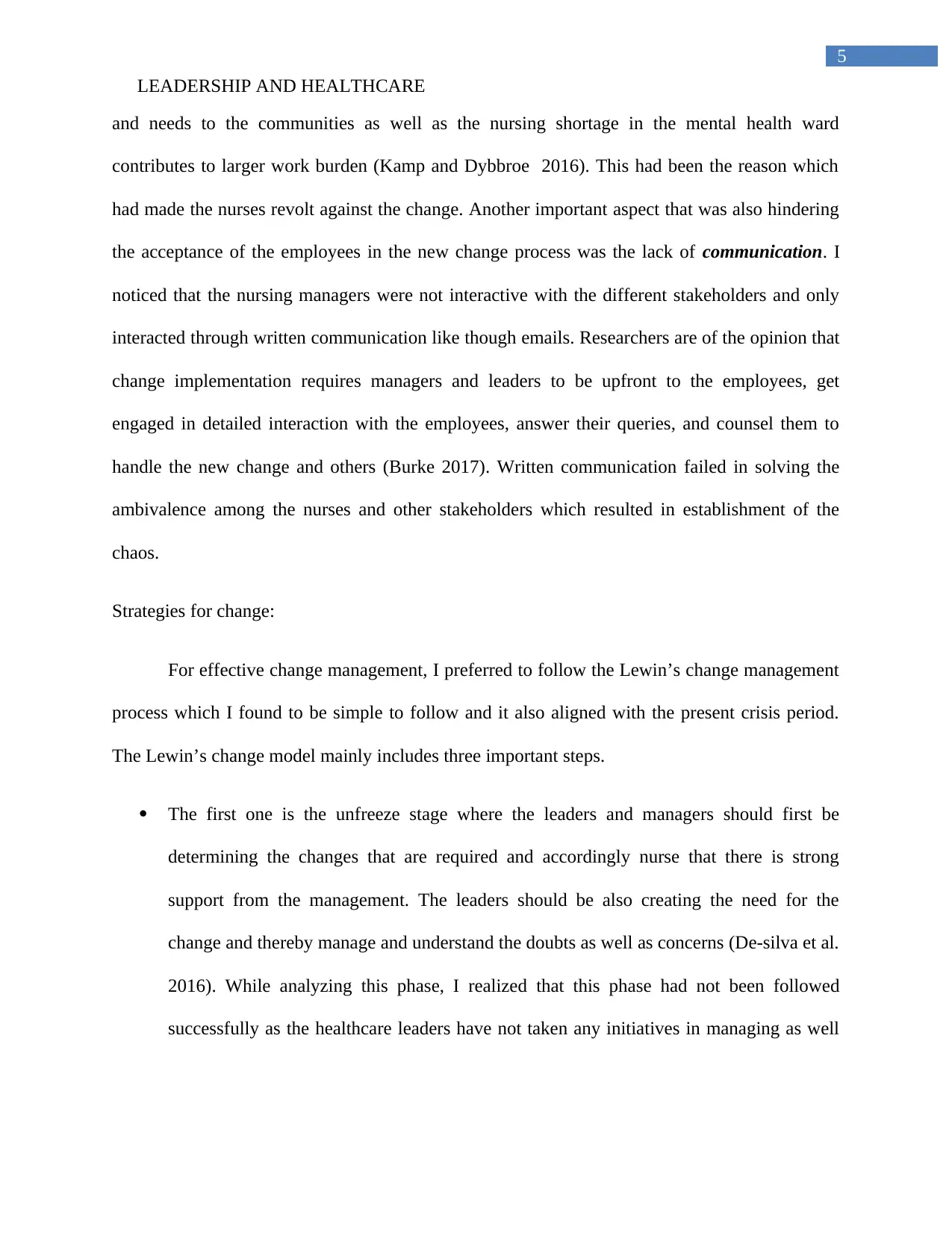
5
LEADERSHIP AND HEALTHCARE
and needs to the communities as well as the nursing shortage in the mental health ward
contributes to larger work burden (Kamp and Dybbroe 2016). This had been the reason which
had made the nurses revolt against the change. Another important aspect that was also hindering
the acceptance of the employees in the new change process was the lack of communication. I
noticed that the nursing managers were not interactive with the different stakeholders and only
interacted through written communication like though emails. Researchers are of the opinion that
change implementation requires managers and leaders to be upfront to the employees, get
engaged in detailed interaction with the employees, answer their queries, and counsel them to
handle the new change and others (Burke 2017). Written communication failed in solving the
ambivalence among the nurses and other stakeholders which resulted in establishment of the
chaos.
Strategies for change:
For effective change management, I preferred to follow the Lewin’s change management
process which I found to be simple to follow and it also aligned with the present crisis period.
The Lewin’s change model mainly includes three important steps.
The first one is the unfreeze stage where the leaders and managers should first be
determining the changes that are required and accordingly nurse that there is strong
support from the management. The leaders should be also creating the need for the
change and thereby manage and understand the doubts as well as concerns (De-silva et al.
2016). While analyzing this phase, I realized that this phase had not been followed
successfully as the healthcare leaders have not taken any initiatives in managing as well
LEADERSHIP AND HEALTHCARE
and needs to the communities as well as the nursing shortage in the mental health ward
contributes to larger work burden (Kamp and Dybbroe 2016). This had been the reason which
had made the nurses revolt against the change. Another important aspect that was also hindering
the acceptance of the employees in the new change process was the lack of communication. I
noticed that the nursing managers were not interactive with the different stakeholders and only
interacted through written communication like though emails. Researchers are of the opinion that
change implementation requires managers and leaders to be upfront to the employees, get
engaged in detailed interaction with the employees, answer their queries, and counsel them to
handle the new change and others (Burke 2017). Written communication failed in solving the
ambivalence among the nurses and other stakeholders which resulted in establishment of the
chaos.
Strategies for change:
For effective change management, I preferred to follow the Lewin’s change management
process which I found to be simple to follow and it also aligned with the present crisis period.
The Lewin’s change model mainly includes three important steps.
The first one is the unfreeze stage where the leaders and managers should first be
determining the changes that are required and accordingly nurse that there is strong
support from the management. The leaders should be also creating the need for the
change and thereby manage and understand the doubts as well as concerns (De-silva et al.
2016). While analyzing this phase, I realized that this phase had not been followed
successfully as the healthcare leaders have not taken any initiatives in managing as well
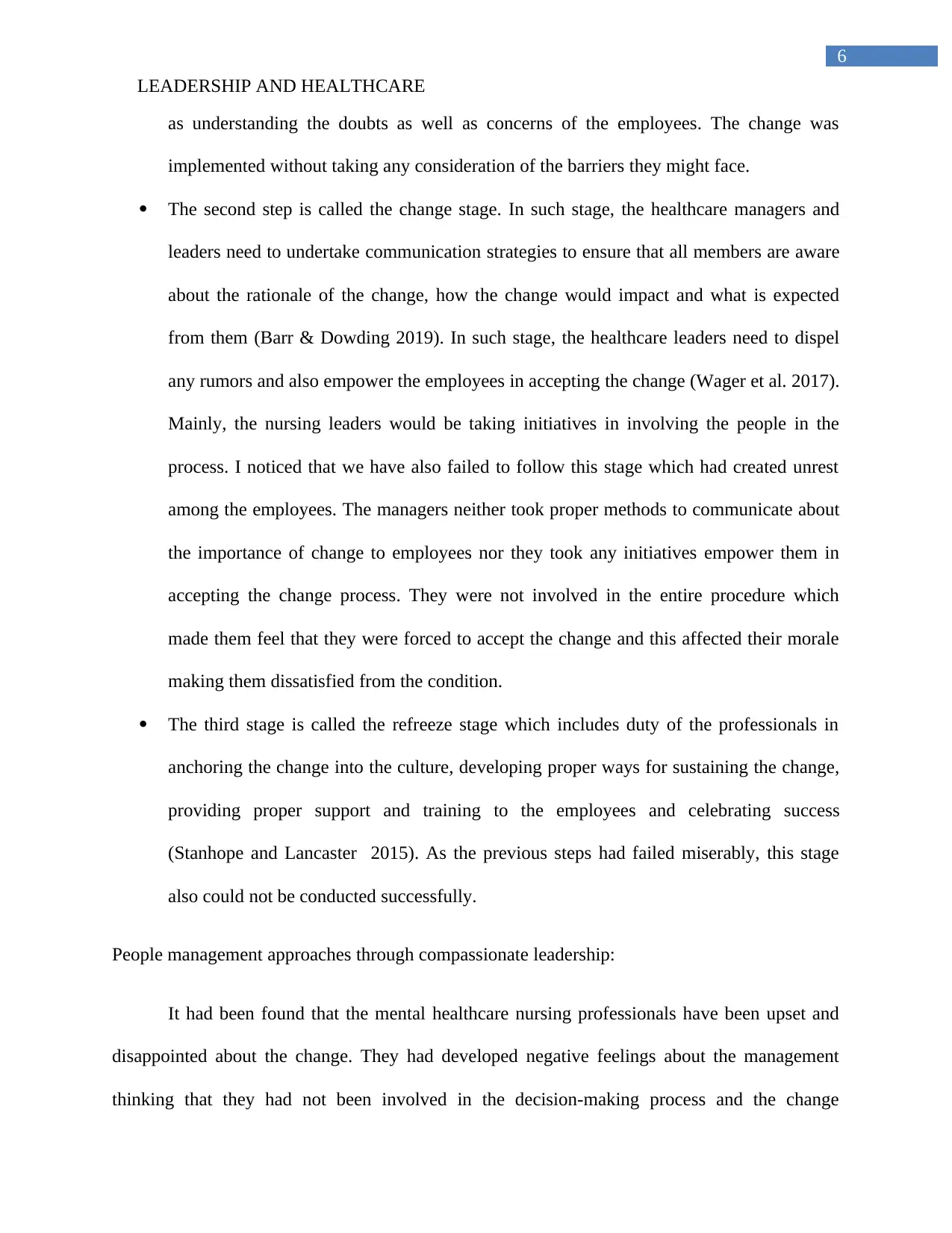
6
LEADERSHIP AND HEALTHCARE
as understanding the doubts as well as concerns of the employees. The change was
implemented without taking any consideration of the barriers they might face.
The second step is called the change stage. In such stage, the healthcare managers and
leaders need to undertake communication strategies to ensure that all members are aware
about the rationale of the change, how the change would impact and what is expected
from them (Barr & Dowding 2019). In such stage, the healthcare leaders need to dispel
any rumors and also empower the employees in accepting the change (Wager et al. 2017).
Mainly, the nursing leaders would be taking initiatives in involving the people in the
process. I noticed that we have also failed to follow this stage which had created unrest
among the employees. The managers neither took proper methods to communicate about
the importance of change to employees nor they took any initiatives empower them in
accepting the change process. They were not involved in the entire procedure which
made them feel that they were forced to accept the change and this affected their morale
making them dissatisfied from the condition.
The third stage is called the refreeze stage which includes duty of the professionals in
anchoring the change into the culture, developing proper ways for sustaining the change,
providing proper support and training to the employees and celebrating success
(Stanhope and Lancaster 2015). As the previous steps had failed miserably, this stage
also could not be conducted successfully.
People management approaches through compassionate leadership:
It had been found that the mental healthcare nursing professionals have been upset and
disappointed about the change. They had developed negative feelings about the management
thinking that they had not been involved in the decision-making process and the change
LEADERSHIP AND HEALTHCARE
as understanding the doubts as well as concerns of the employees. The change was
implemented without taking any consideration of the barriers they might face.
The second step is called the change stage. In such stage, the healthcare managers and
leaders need to undertake communication strategies to ensure that all members are aware
about the rationale of the change, how the change would impact and what is expected
from them (Barr & Dowding 2019). In such stage, the healthcare leaders need to dispel
any rumors and also empower the employees in accepting the change (Wager et al. 2017).
Mainly, the nursing leaders would be taking initiatives in involving the people in the
process. I noticed that we have also failed to follow this stage which had created unrest
among the employees. The managers neither took proper methods to communicate about
the importance of change to employees nor they took any initiatives empower them in
accepting the change process. They were not involved in the entire procedure which
made them feel that they were forced to accept the change and this affected their morale
making them dissatisfied from the condition.
The third stage is called the refreeze stage which includes duty of the professionals in
anchoring the change into the culture, developing proper ways for sustaining the change,
providing proper support and training to the employees and celebrating success
(Stanhope and Lancaster 2015). As the previous steps had failed miserably, this stage
also could not be conducted successfully.
People management approaches through compassionate leadership:
It had been found that the mental healthcare nursing professionals have been upset and
disappointed about the change. They had developed negative feelings about the management
thinking that they had not been involved in the decision-making process and the change
Paraphrase This Document
Need a fresh take? Get an instant paraphrase of this document with our AI Paraphraser
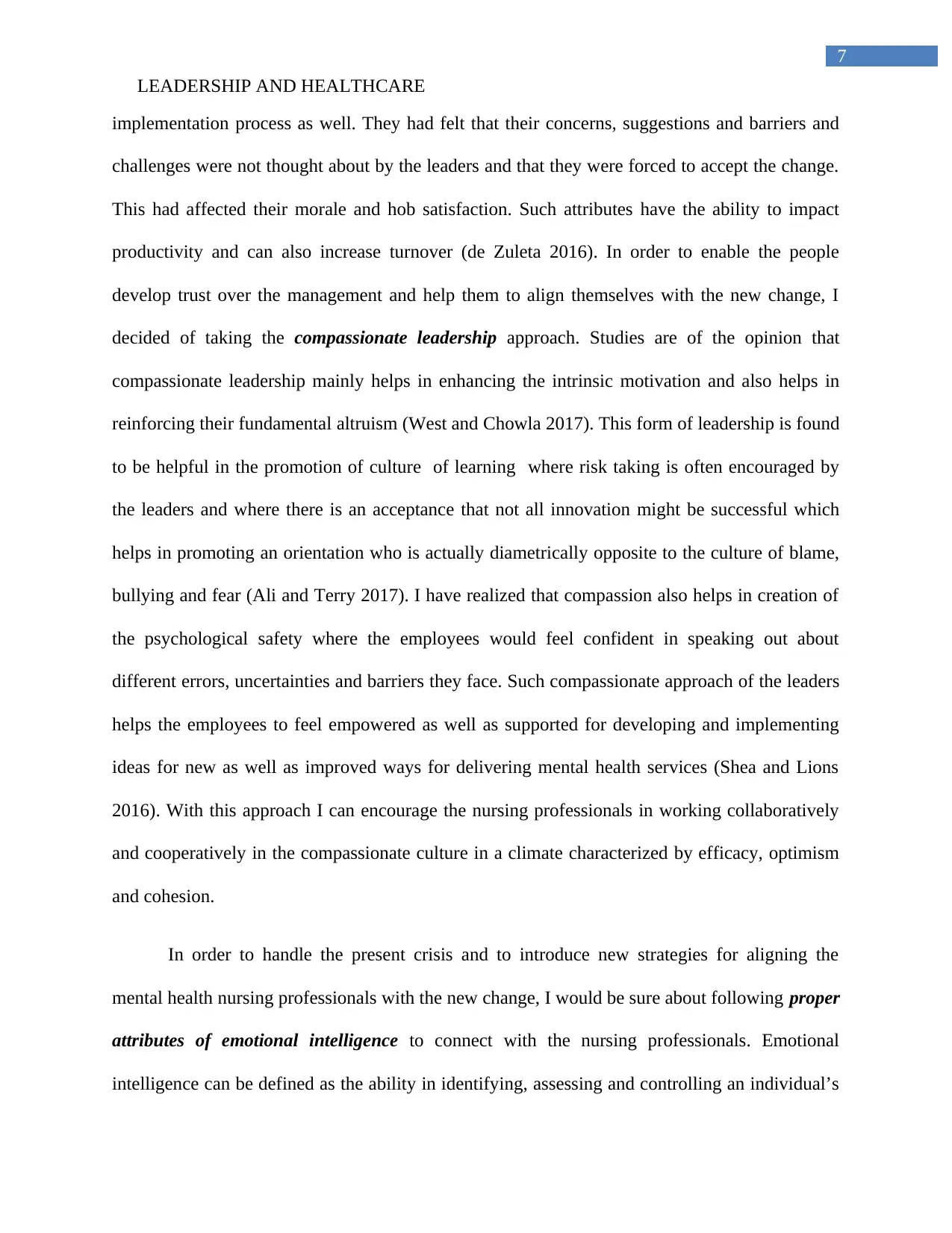
7
LEADERSHIP AND HEALTHCARE
implementation process as well. They had felt that their concerns, suggestions and barriers and
challenges were not thought about by the leaders and that they were forced to accept the change.
This had affected their morale and hob satisfaction. Such attributes have the ability to impact
productivity and can also increase turnover (de Zuleta 2016). In order to enable the people
develop trust over the management and help them to align themselves with the new change, I
decided of taking the compassionate leadership approach. Studies are of the opinion that
compassionate leadership mainly helps in enhancing the intrinsic motivation and also helps in
reinforcing their fundamental altruism (West and Chowla 2017). This form of leadership is found
to be helpful in the promotion of culture of learning where risk taking is often encouraged by
the leaders and where there is an acceptance that not all innovation might be successful which
helps in promoting an orientation who is actually diametrically opposite to the culture of blame,
bullying and fear (Ali and Terry 2017). I have realized that compassion also helps in creation of
the psychological safety where the employees would feel confident in speaking out about
different errors, uncertainties and barriers they face. Such compassionate approach of the leaders
helps the employees to feel empowered as well as supported for developing and implementing
ideas for new as well as improved ways for delivering mental health services (Shea and Lions
2016). With this approach I can encourage the nursing professionals in working collaboratively
and cooperatively in the compassionate culture in a climate characterized by efficacy, optimism
and cohesion.
In order to handle the present crisis and to introduce new strategies for aligning the
mental health nursing professionals with the new change, I would be sure about following proper
attributes of emotional intelligence to connect with the nursing professionals. Emotional
intelligence can be defined as the ability in identifying, assessing and controlling an individual’s
LEADERSHIP AND HEALTHCARE
implementation process as well. They had felt that their concerns, suggestions and barriers and
challenges were not thought about by the leaders and that they were forced to accept the change.
This had affected their morale and hob satisfaction. Such attributes have the ability to impact
productivity and can also increase turnover (de Zuleta 2016). In order to enable the people
develop trust over the management and help them to align themselves with the new change, I
decided of taking the compassionate leadership approach. Studies are of the opinion that
compassionate leadership mainly helps in enhancing the intrinsic motivation and also helps in
reinforcing their fundamental altruism (West and Chowla 2017). This form of leadership is found
to be helpful in the promotion of culture of learning where risk taking is often encouraged by
the leaders and where there is an acceptance that not all innovation might be successful which
helps in promoting an orientation who is actually diametrically opposite to the culture of blame,
bullying and fear (Ali and Terry 2017). I have realized that compassion also helps in creation of
the psychological safety where the employees would feel confident in speaking out about
different errors, uncertainties and barriers they face. Such compassionate approach of the leaders
helps the employees to feel empowered as well as supported for developing and implementing
ideas for new as well as improved ways for delivering mental health services (Shea and Lions
2016). With this approach I can encourage the nursing professionals in working collaboratively
and cooperatively in the compassionate culture in a climate characterized by efficacy, optimism
and cohesion.
In order to handle the present crisis and to introduce new strategies for aligning the
mental health nursing professionals with the new change, I would be sure about following proper
attributes of emotional intelligence to connect with the nursing professionals. Emotional
intelligence can be defined as the ability in identifying, assessing and controlling an individual’s
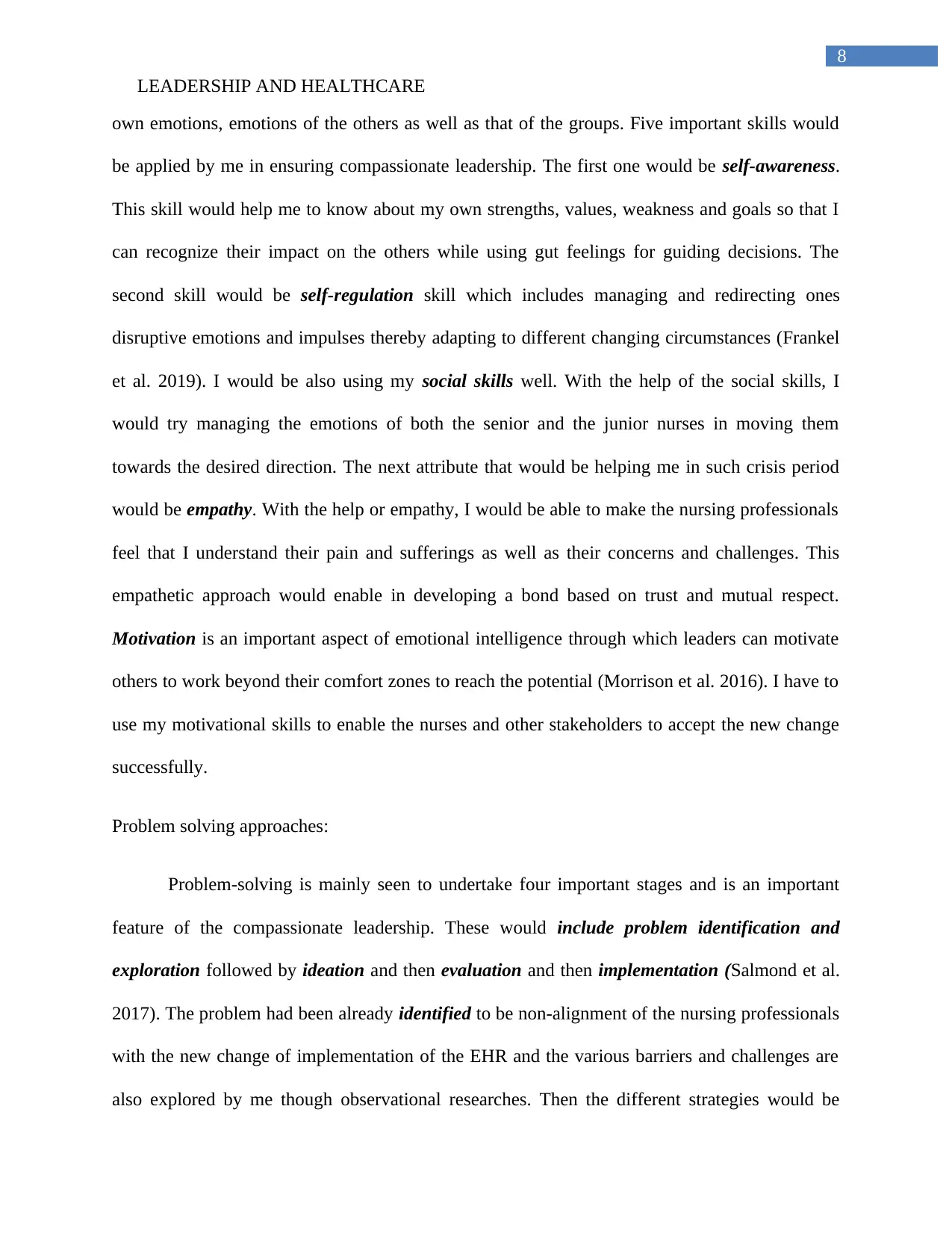
8
LEADERSHIP AND HEALTHCARE
own emotions, emotions of the others as well as that of the groups. Five important skills would
be applied by me in ensuring compassionate leadership. The first one would be self-awareness.
This skill would help me to know about my own strengths, values, weakness and goals so that I
can recognize their impact on the others while using gut feelings for guiding decisions. The
second skill would be self-regulation skill which includes managing and redirecting ones
disruptive emotions and impulses thereby adapting to different changing circumstances (Frankel
et al. 2019). I would be also using my social skills well. With the help of the social skills, I
would try managing the emotions of both the senior and the junior nurses in moving them
towards the desired direction. The next attribute that would be helping me in such crisis period
would be empathy. With the help or empathy, I would be able to make the nursing professionals
feel that I understand their pain and sufferings as well as their concerns and challenges. This
empathetic approach would enable in developing a bond based on trust and mutual respect.
Motivation is an important aspect of emotional intelligence through which leaders can motivate
others to work beyond their comfort zones to reach the potential (Morrison et al. 2016). I have to
use my motivational skills to enable the nurses and other stakeholders to accept the new change
successfully.
Problem solving approaches:
Problem-solving is mainly seen to undertake four important stages and is an important
feature of the compassionate leadership. These would include problem identification and
exploration followed by ideation and then evaluation and then implementation (Salmond et al.
2017). The problem had been already identified to be non-alignment of the nursing professionals
with the new change of implementation of the EHR and the various barriers and challenges are
also explored by me though observational researches. Then the different strategies would be
LEADERSHIP AND HEALTHCARE
own emotions, emotions of the others as well as that of the groups. Five important skills would
be applied by me in ensuring compassionate leadership. The first one would be self-awareness.
This skill would help me to know about my own strengths, values, weakness and goals so that I
can recognize their impact on the others while using gut feelings for guiding decisions. The
second skill would be self-regulation skill which includes managing and redirecting ones
disruptive emotions and impulses thereby adapting to different changing circumstances (Frankel
et al. 2019). I would be also using my social skills well. With the help of the social skills, I
would try managing the emotions of both the senior and the junior nurses in moving them
towards the desired direction. The next attribute that would be helping me in such crisis period
would be empathy. With the help or empathy, I would be able to make the nursing professionals
feel that I understand their pain and sufferings as well as their concerns and challenges. This
empathetic approach would enable in developing a bond based on trust and mutual respect.
Motivation is an important aspect of emotional intelligence through which leaders can motivate
others to work beyond their comfort zones to reach the potential (Morrison et al. 2016). I have to
use my motivational skills to enable the nurses and other stakeholders to accept the new change
successfully.
Problem solving approaches:
Problem-solving is mainly seen to undertake four important stages and is an important
feature of the compassionate leadership. These would include problem identification and
exploration followed by ideation and then evaluation and then implementation (Salmond et al.
2017). The problem had been already identified to be non-alignment of the nursing professionals
with the new change of implementation of the EHR and the various barriers and challenges are
also explored by me though observational researches. Then the different strategies would be
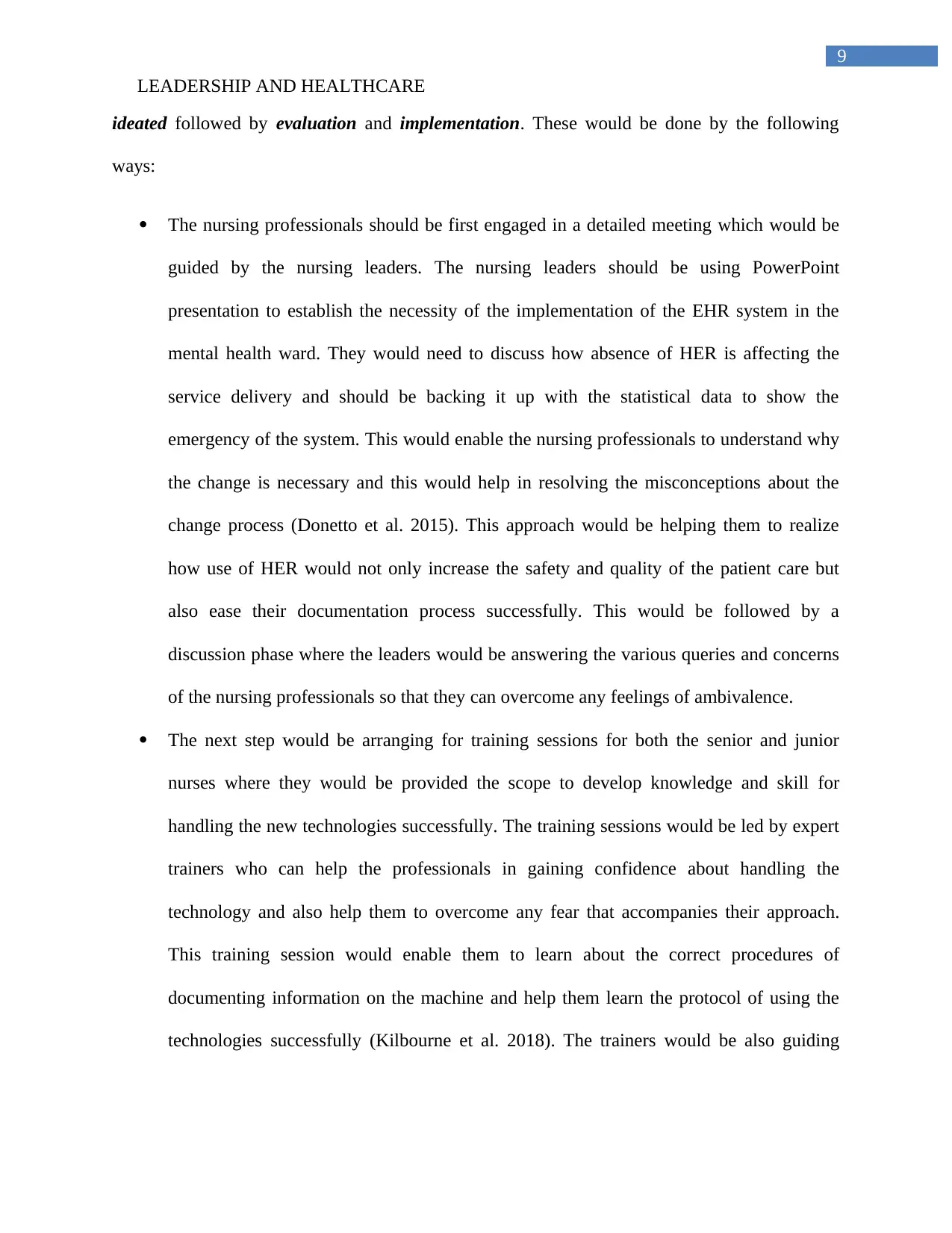
9
LEADERSHIP AND HEALTHCARE
ideated followed by evaluation and implementation. These would be done by the following
ways:
The nursing professionals should be first engaged in a detailed meeting which would be
guided by the nursing leaders. The nursing leaders should be using PowerPoint
presentation to establish the necessity of the implementation of the EHR system in the
mental health ward. They would need to discuss how absence of HER is affecting the
service delivery and should be backing it up with the statistical data to show the
emergency of the system. This would enable the nursing professionals to understand why
the change is necessary and this would help in resolving the misconceptions about the
change process (Donetto et al. 2015). This approach would be helping them to realize
how use of HER would not only increase the safety and quality of the patient care but
also ease their documentation process successfully. This would be followed by a
discussion phase where the leaders would be answering the various queries and concerns
of the nursing professionals so that they can overcome any feelings of ambivalence.
The next step would be arranging for training sessions for both the senior and junior
nurses where they would be provided the scope to develop knowledge and skill for
handling the new technologies successfully. The training sessions would be led by expert
trainers who can help the professionals in gaining confidence about handling the
technology and also help them to overcome any fear that accompanies their approach.
This training session would enable them to learn about the correct procedures of
documenting information on the machine and help them learn the protocol of using the
technologies successfully (Kilbourne et al. 2018). The trainers would be also guiding
LEADERSHIP AND HEALTHCARE
ideated followed by evaluation and implementation. These would be done by the following
ways:
The nursing professionals should be first engaged in a detailed meeting which would be
guided by the nursing leaders. The nursing leaders should be using PowerPoint
presentation to establish the necessity of the implementation of the EHR system in the
mental health ward. They would need to discuss how absence of HER is affecting the
service delivery and should be backing it up with the statistical data to show the
emergency of the system. This would enable the nursing professionals to understand why
the change is necessary and this would help in resolving the misconceptions about the
change process (Donetto et al. 2015). This approach would be helping them to realize
how use of HER would not only increase the safety and quality of the patient care but
also ease their documentation process successfully. This would be followed by a
discussion phase where the leaders would be answering the various queries and concerns
of the nursing professionals so that they can overcome any feelings of ambivalence.
The next step would be arranging for training sessions for both the senior and junior
nurses where they would be provided the scope to develop knowledge and skill for
handling the new technologies successfully. The training sessions would be led by expert
trainers who can help the professionals in gaining confidence about handling the
technology and also help them to overcome any fear that accompanies their approach.
This training session would enable them to learn about the correct procedures of
documenting information on the machine and help them learn the protocol of using the
technologies successfully (Kilbourne et al. 2018). The trainers would be also guiding
Secure Best Marks with AI Grader
Need help grading? Try our AI Grader for instant feedback on your assignments.
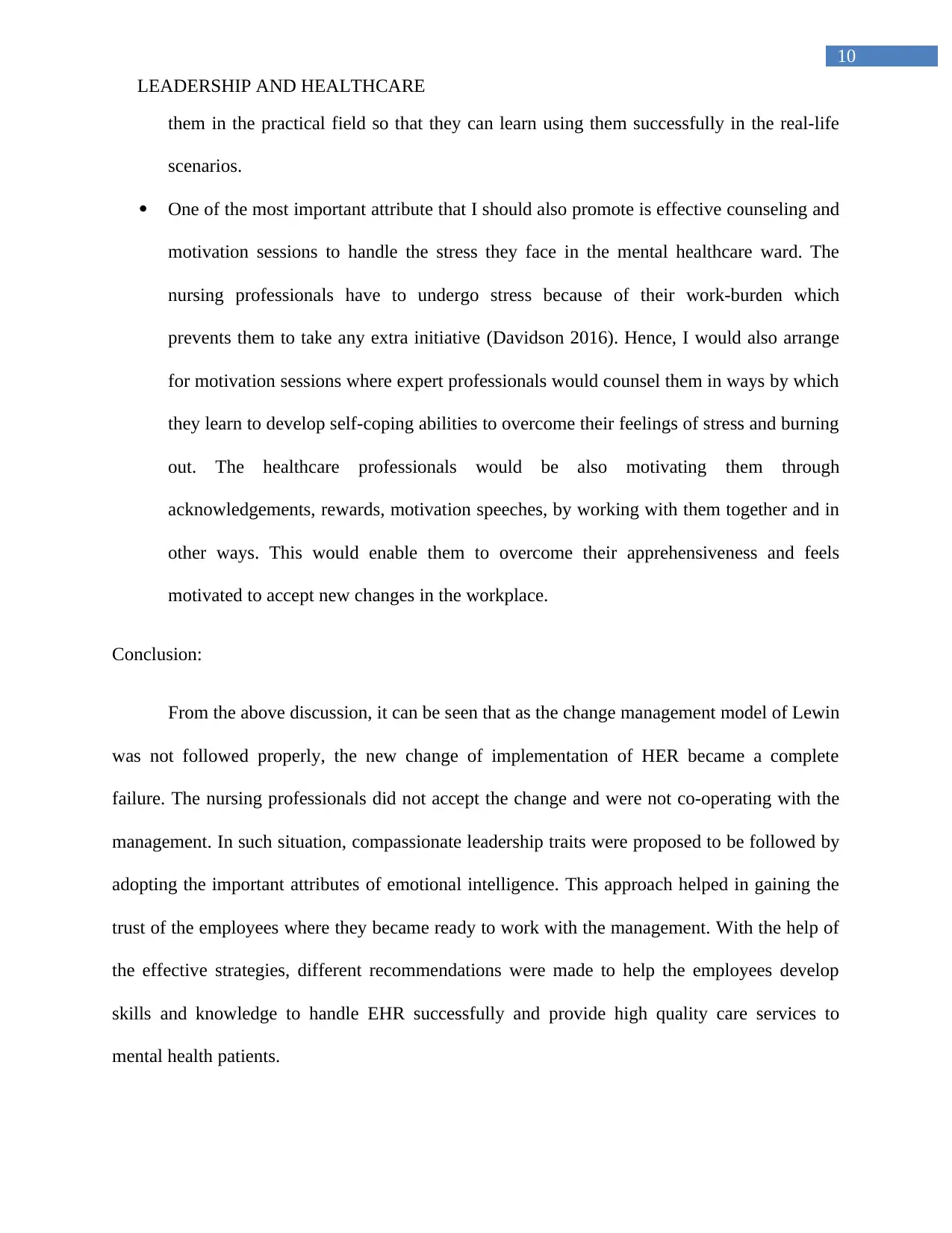
10
LEADERSHIP AND HEALTHCARE
them in the practical field so that they can learn using them successfully in the real-life
scenarios.
One of the most important attribute that I should also promote is effective counseling and
motivation sessions to handle the stress they face in the mental healthcare ward. The
nursing professionals have to undergo stress because of their work-burden which
prevents them to take any extra initiative (Davidson 2016). Hence, I would also arrange
for motivation sessions where expert professionals would counsel them in ways by which
they learn to develop self-coping abilities to overcome their feelings of stress and burning
out. The healthcare professionals would be also motivating them through
acknowledgements, rewards, motivation speeches, by working with them together and in
other ways. This would enable them to overcome their apprehensiveness and feels
motivated to accept new changes in the workplace.
Conclusion:
From the above discussion, it can be seen that as the change management model of Lewin
was not followed properly, the new change of implementation of HER became a complete
failure. The nursing professionals did not accept the change and were not co-operating with the
management. In such situation, compassionate leadership traits were proposed to be followed by
adopting the important attributes of emotional intelligence. This approach helped in gaining the
trust of the employees where they became ready to work with the management. With the help of
the effective strategies, different recommendations were made to help the employees develop
skills and knowledge to handle EHR successfully and provide high quality care services to
mental health patients.
LEADERSHIP AND HEALTHCARE
them in the practical field so that they can learn using them successfully in the real-life
scenarios.
One of the most important attribute that I should also promote is effective counseling and
motivation sessions to handle the stress they face in the mental healthcare ward. The
nursing professionals have to undergo stress because of their work-burden which
prevents them to take any extra initiative (Davidson 2016). Hence, I would also arrange
for motivation sessions where expert professionals would counsel them in ways by which
they learn to develop self-coping abilities to overcome their feelings of stress and burning
out. The healthcare professionals would be also motivating them through
acknowledgements, rewards, motivation speeches, by working with them together and in
other ways. This would enable them to overcome their apprehensiveness and feels
motivated to accept new changes in the workplace.
Conclusion:
From the above discussion, it can be seen that as the change management model of Lewin
was not followed properly, the new change of implementation of HER became a complete
failure. The nursing professionals did not accept the change and were not co-operating with the
management. In such situation, compassionate leadership traits were proposed to be followed by
adopting the important attributes of emotional intelligence. This approach helped in gaining the
trust of the employees where they became ready to work with the management. With the help of
the effective strategies, different recommendations were made to help the employees develop
skills and knowledge to handle EHR successfully and provide high quality care services to
mental health patients.
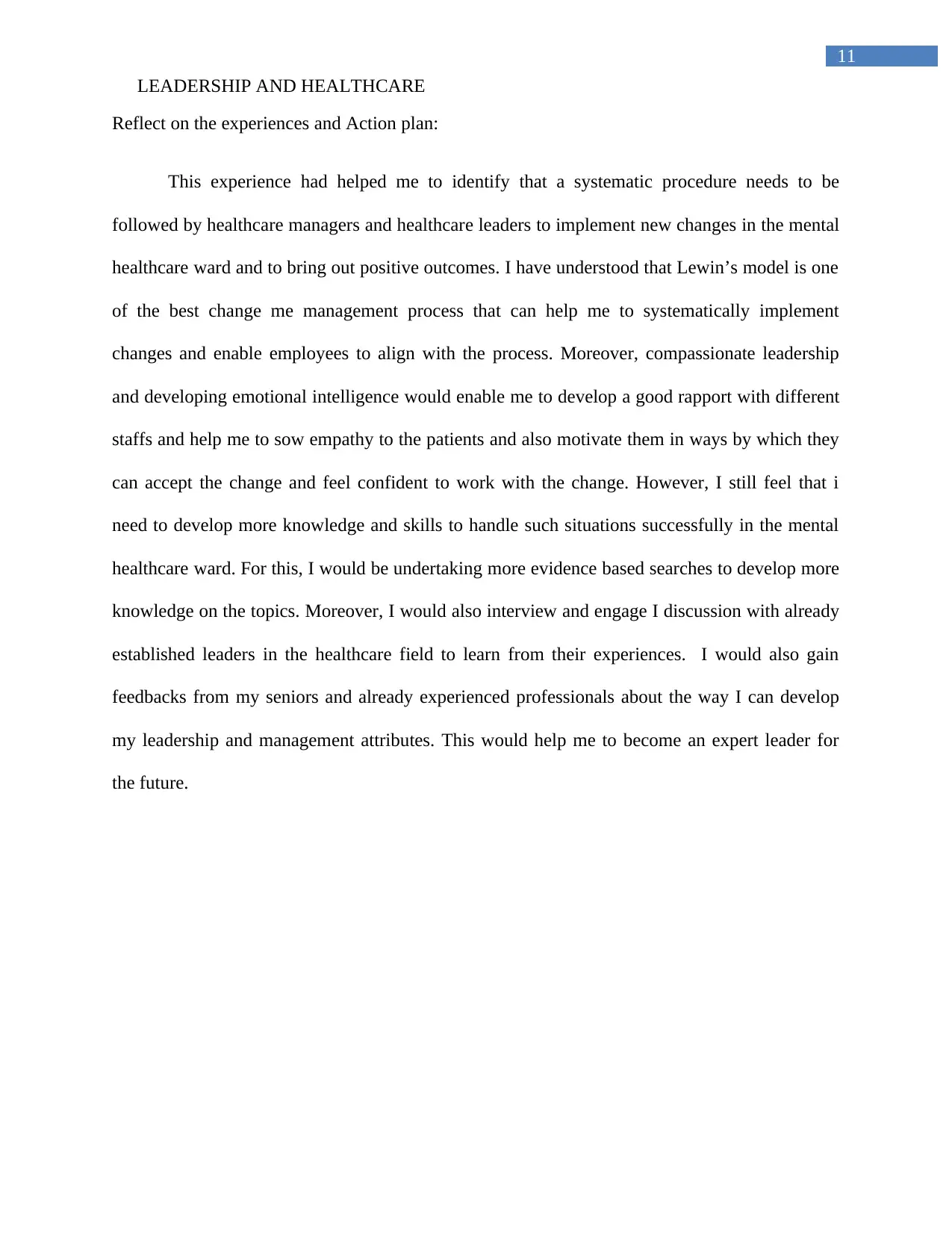
11
LEADERSHIP AND HEALTHCARE
Reflect on the experiences and Action plan:
This experience had helped me to identify that a systematic procedure needs to be
followed by healthcare managers and healthcare leaders to implement new changes in the mental
healthcare ward and to bring out positive outcomes. I have understood that Lewin’s model is one
of the best change me management process that can help me to systematically implement
changes and enable employees to align with the process. Moreover, compassionate leadership
and developing emotional intelligence would enable me to develop a good rapport with different
staffs and help me to sow empathy to the patients and also motivate them in ways by which they
can accept the change and feel confident to work with the change. However, I still feel that i
need to develop more knowledge and skills to handle such situations successfully in the mental
healthcare ward. For this, I would be undertaking more evidence based searches to develop more
knowledge on the topics. Moreover, I would also interview and engage I discussion with already
established leaders in the healthcare field to learn from their experiences. I would also gain
feedbacks from my seniors and already experienced professionals about the way I can develop
my leadership and management attributes. This would help me to become an expert leader for
the future.
LEADERSHIP AND HEALTHCARE
Reflect on the experiences and Action plan:
This experience had helped me to identify that a systematic procedure needs to be
followed by healthcare managers and healthcare leaders to implement new changes in the mental
healthcare ward and to bring out positive outcomes. I have understood that Lewin’s model is one
of the best change me management process that can help me to systematically implement
changes and enable employees to align with the process. Moreover, compassionate leadership
and developing emotional intelligence would enable me to develop a good rapport with different
staffs and help me to sow empathy to the patients and also motivate them in ways by which they
can accept the change and feel confident to work with the change. However, I still feel that i
need to develop more knowledge and skills to handle such situations successfully in the mental
healthcare ward. For this, I would be undertaking more evidence based searches to develop more
knowledge on the topics. Moreover, I would also interview and engage I discussion with already
established leaders in the healthcare field to learn from their experiences. I would also gain
feedbacks from my seniors and already experienced professionals about the way I can develop
my leadership and management attributes. This would help me to become an expert leader for
the future.
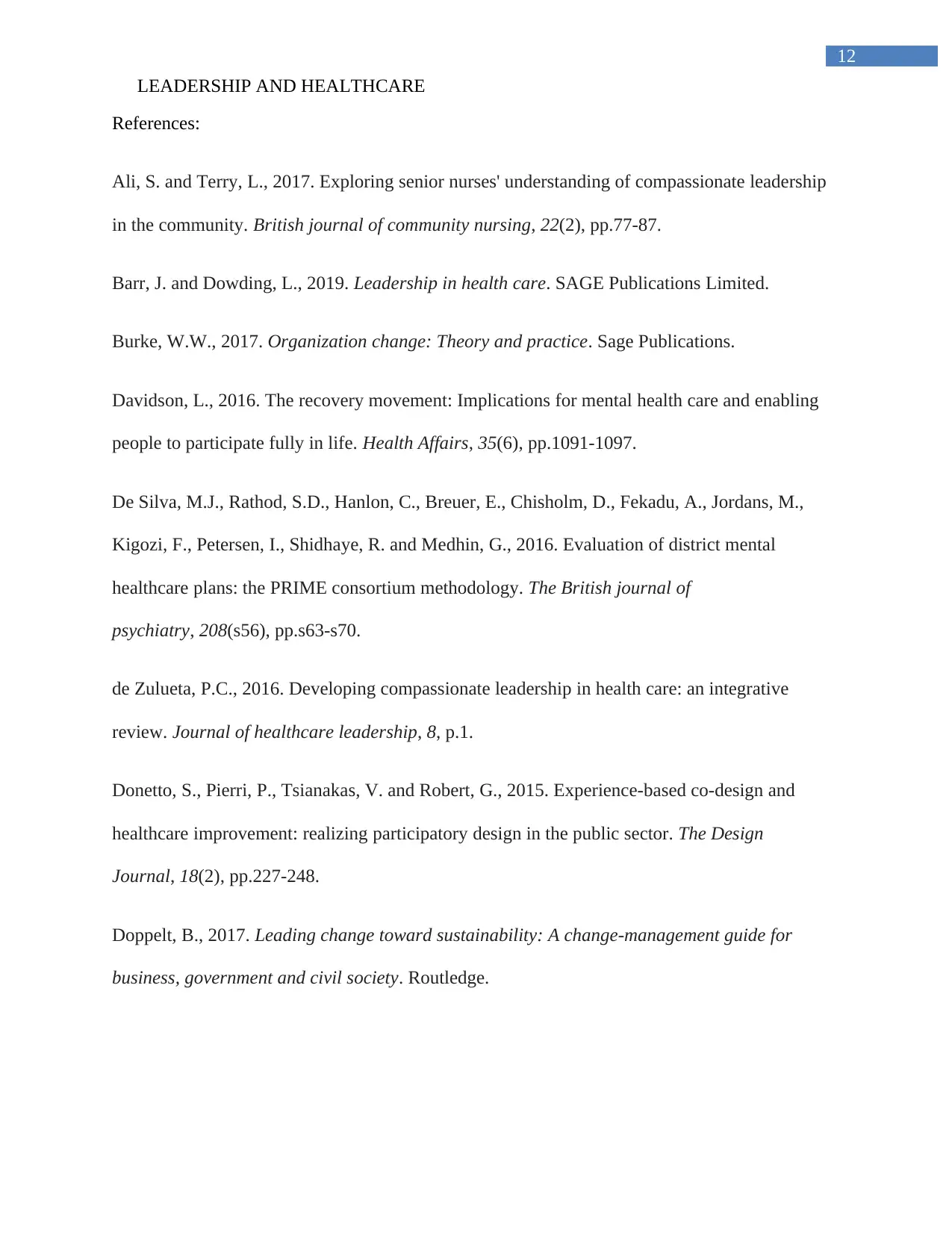
12
LEADERSHIP AND HEALTHCARE
References:
Ali, S. and Terry, L., 2017. Exploring senior nurses' understanding of compassionate leadership
in the community. British journal of community nursing, 22(2), pp.77-87.
Barr, J. and Dowding, L., 2019. Leadership in health care. SAGE Publications Limited.
Burke, W.W., 2017. Organization change: Theory and practice. Sage Publications.
Davidson, L., 2016. The recovery movement: Implications for mental health care and enabling
people to participate fully in life. Health Affairs, 35(6), pp.1091-1097.
De Silva, M.J., Rathod, S.D., Hanlon, C., Breuer, E., Chisholm, D., Fekadu, A., Jordans, M.,
Kigozi, F., Petersen, I., Shidhaye, R. and Medhin, G., 2016. Evaluation of district mental
healthcare plans: the PRIME consortium methodology. The British journal of
psychiatry, 208(s56), pp.s63-s70.
de Zulueta, P.C., 2016. Developing compassionate leadership in health care: an integrative
review. Journal of healthcare leadership, 8, p.1.
Donetto, S., Pierri, P., Tsianakas, V. and Robert, G., 2015. Experience-based co-design and
healthcare improvement: realizing participatory design in the public sector. The Design
Journal, 18(2), pp.227-248.
Doppelt, B., 2017. Leading change toward sustainability: A change-management guide for
business, government and civil society. Routledge.
LEADERSHIP AND HEALTHCARE
References:
Ali, S. and Terry, L., 2017. Exploring senior nurses' understanding of compassionate leadership
in the community. British journal of community nursing, 22(2), pp.77-87.
Barr, J. and Dowding, L., 2019. Leadership in health care. SAGE Publications Limited.
Burke, W.W., 2017. Organization change: Theory and practice. Sage Publications.
Davidson, L., 2016. The recovery movement: Implications for mental health care and enabling
people to participate fully in life. Health Affairs, 35(6), pp.1091-1097.
De Silva, M.J., Rathod, S.D., Hanlon, C., Breuer, E., Chisholm, D., Fekadu, A., Jordans, M.,
Kigozi, F., Petersen, I., Shidhaye, R. and Medhin, G., 2016. Evaluation of district mental
healthcare plans: the PRIME consortium methodology. The British journal of
psychiatry, 208(s56), pp.s63-s70.
de Zulueta, P.C., 2016. Developing compassionate leadership in health care: an integrative
review. Journal of healthcare leadership, 8, p.1.
Donetto, S., Pierri, P., Tsianakas, V. and Robert, G., 2015. Experience-based co-design and
healthcare improvement: realizing participatory design in the public sector. The Design
Journal, 18(2), pp.227-248.
Doppelt, B., 2017. Leading change toward sustainability: A change-management guide for
business, government and civil society. Routledge.
Paraphrase This Document
Need a fresh take? Get an instant paraphrase of this document with our AI Paraphraser
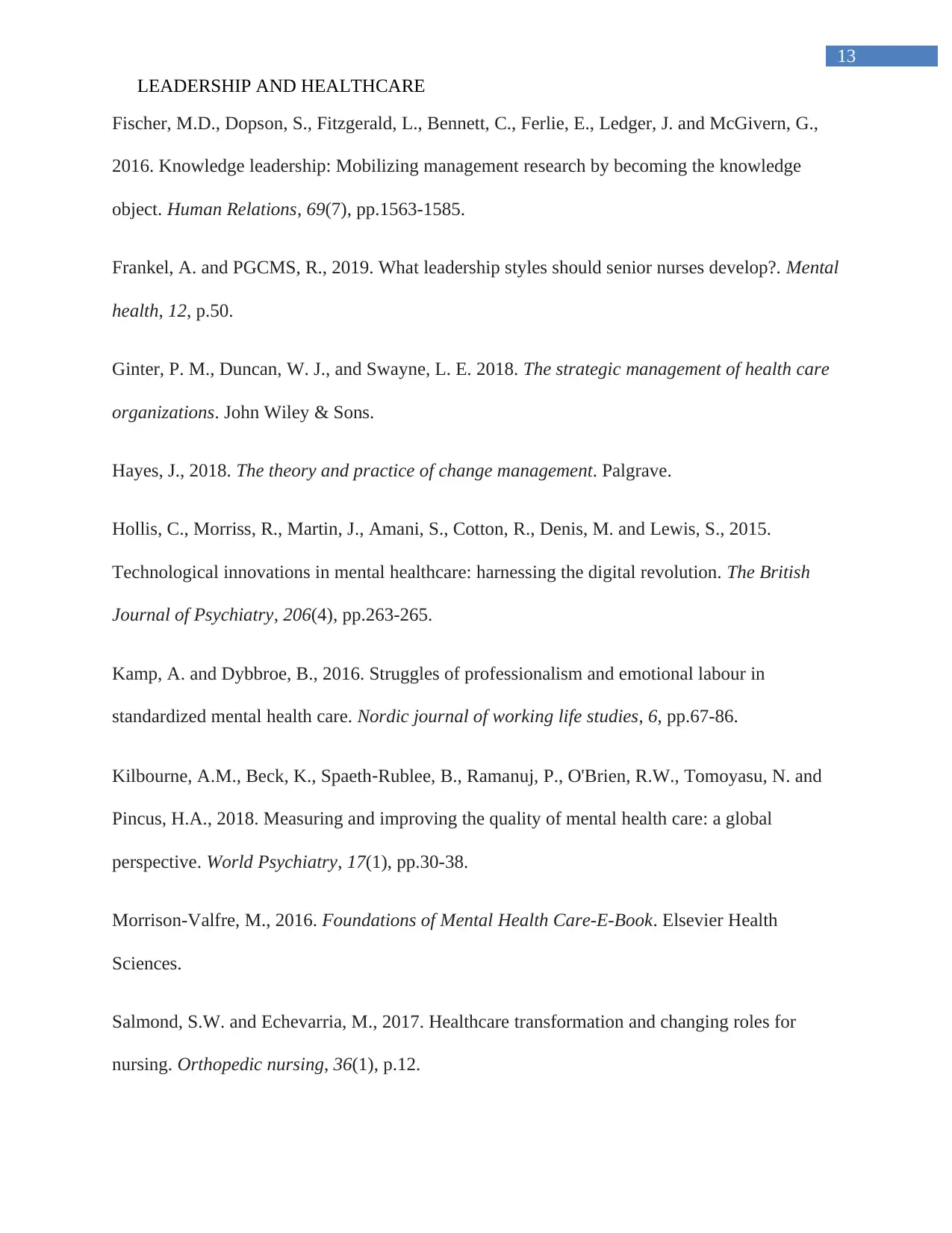
13
LEADERSHIP AND HEALTHCARE
Fischer, M.D., Dopson, S., Fitzgerald, L., Bennett, C., Ferlie, E., Ledger, J. and McGivern, G.,
2016. Knowledge leadership: Mobilizing management research by becoming the knowledge
object. Human Relations, 69(7), pp.1563-1585.
Frankel, A. and PGCMS, R., 2019. What leadership styles should senior nurses develop?. Mental
health, 12, p.50.
Ginter, P. M., Duncan, W. J., and Swayne, L. E. 2018. The strategic management of health care
organizations. John Wiley & Sons.
Hayes, J., 2018. The theory and practice of change management. Palgrave.
Hollis, C., Morriss, R., Martin, J., Amani, S., Cotton, R., Denis, M. and Lewis, S., 2015.
Technological innovations in mental healthcare: harnessing the digital revolution. The British
Journal of Psychiatry, 206(4), pp.263-265.
Kamp, A. and Dybbroe, B., 2016. Struggles of professionalism and emotional labour in
standardized mental health care. Nordic journal of working life studies, 6, pp.67-86.
Kilbourne, A.M., Beck, K., Spaeth‐Rublee, B., Ramanuj, P., O'Brien, R.W., Tomoyasu, N. and
Pincus, H.A., 2018. Measuring and improving the quality of mental health care: a global
perspective. World Psychiatry, 17(1), pp.30-38.
Morrison-Valfre, M., 2016. Foundations of Mental Health Care-E-Book. Elsevier Health
Sciences.
Salmond, S.W. and Echevarria, M., 2017. Healthcare transformation and changing roles for
nursing. Orthopedic nursing, 36(1), p.12.
LEADERSHIP AND HEALTHCARE
Fischer, M.D., Dopson, S., Fitzgerald, L., Bennett, C., Ferlie, E., Ledger, J. and McGivern, G.,
2016. Knowledge leadership: Mobilizing management research by becoming the knowledge
object. Human Relations, 69(7), pp.1563-1585.
Frankel, A. and PGCMS, R., 2019. What leadership styles should senior nurses develop?. Mental
health, 12, p.50.
Ginter, P. M., Duncan, W. J., and Swayne, L. E. 2018. The strategic management of health care
organizations. John Wiley & Sons.
Hayes, J., 2018. The theory and practice of change management. Palgrave.
Hollis, C., Morriss, R., Martin, J., Amani, S., Cotton, R., Denis, M. and Lewis, S., 2015.
Technological innovations in mental healthcare: harnessing the digital revolution. The British
Journal of Psychiatry, 206(4), pp.263-265.
Kamp, A. and Dybbroe, B., 2016. Struggles of professionalism and emotional labour in
standardized mental health care. Nordic journal of working life studies, 6, pp.67-86.
Kilbourne, A.M., Beck, K., Spaeth‐Rublee, B., Ramanuj, P., O'Brien, R.W., Tomoyasu, N. and
Pincus, H.A., 2018. Measuring and improving the quality of mental health care: a global
perspective. World Psychiatry, 17(1), pp.30-38.
Morrison-Valfre, M., 2016. Foundations of Mental Health Care-E-Book. Elsevier Health
Sciences.
Salmond, S.W. and Echevarria, M., 2017. Healthcare transformation and changing roles for
nursing. Orthopedic nursing, 36(1), p.12.

14
LEADERSHIP AND HEALTHCARE
Shea, S. and Lionis, C., 2016. Compassionate Leadership: Promoting Non-Discriminatory
Practice toward Older Employees in Healthcare. In The Aging Workforce Handbook: Individual,
Organizational, and Societal Challenges (pp. 537-555). Emerald Group Publishing Limited.
Slade, M., 2017. Implementing shared decision making in routine mental health care. World
psychiatry, 16(2), pp.146-153.
Stanhope, M. and Lancaster, J., 2015. Public health nursing-e-book: Population-centered health
care in the community. Elsevier Health Sciences.
Thomas, P., 2017. Integrating Primary Healthcare: leading, managing, facilitating. CRC Press.
Wager, K.A., Lee, F.W. and Glaser, J.P., 2017. Health care information systems: a practical
approach for health care management. John Wiley & Sons.
Wellman, J., Jeffries, H. and Hagan, P., 2016. Leading the lean healthcare journey: driving
culture change to increase value. CRC Press.
West, M.S. and Chowla, R., 2017. Compassionate leadership for compassionate health
care. Compassion: concepts, research and applications. London: Routledge, pp.237-57.
LEADERSHIP AND HEALTHCARE
Shea, S. and Lionis, C., 2016. Compassionate Leadership: Promoting Non-Discriminatory
Practice toward Older Employees in Healthcare. In The Aging Workforce Handbook: Individual,
Organizational, and Societal Challenges (pp. 537-555). Emerald Group Publishing Limited.
Slade, M., 2017. Implementing shared decision making in routine mental health care. World
psychiatry, 16(2), pp.146-153.
Stanhope, M. and Lancaster, J., 2015. Public health nursing-e-book: Population-centered health
care in the community. Elsevier Health Sciences.
Thomas, P., 2017. Integrating Primary Healthcare: leading, managing, facilitating. CRC Press.
Wager, K.A., Lee, F.W. and Glaser, J.P., 2017. Health care information systems: a practical
approach for health care management. John Wiley & Sons.
Wellman, J., Jeffries, H. and Hagan, P., 2016. Leading the lean healthcare journey: driving
culture change to increase value. CRC Press.
West, M.S. and Chowla, R., 2017. Compassionate leadership for compassionate health
care. Compassion: concepts, research and applications. London: Routledge, pp.237-57.
1 out of 15
Related Documents
Your All-in-One AI-Powered Toolkit for Academic Success.
+13062052269
info@desklib.com
Available 24*7 on WhatsApp / Email
![[object Object]](/_next/static/media/star-bottom.7253800d.svg)
Unlock your academic potential
© 2024 | Zucol Services PVT LTD | All rights reserved.




